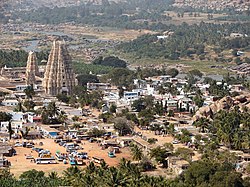Hampi
| Hampi | ||
|---|---|---|
|
|
||
| State : |
|
|
| State : | Karnataka | |
| District : | Bellary | |
| Sub-district : | Hospet | |
| Location : | 15 ° 20 ′ N , 76 ° 28 ′ E | |
| Height : | 426 m | |
| Residents : | 2,777 (2011) | |
| View over the place - 2011 | ||
Hampi ( Kannada : ಹಂಪೆ Hampe ) is a historic site in the Indian state of Karnataka .
From around 1343 to 1565, Hampi was the capital of the Kingdom of Vijayanagar . At the height of his power, Vijayanagar, considered the last great Hindu empire, controlled almost all of southern India. Its capital is said to have had around 200,000, according to other estimates, even 500,000 inhabitants during the heyday. Today Hampi is only a village with 2777 inhabitants (2011 census). Hampi belongs since 1986 to UNESCO - World Heritage Site .
Hampi is located on the south bank of the Tungabhadra River twelve kilometers northeast of the city of Hospet in the Bellary district in east-central Karnataka. The ruins of the city are scattered over 26 square kilometers in what used to be a defensible area south of the Tungabhadra River, and on the other side the area is bordered by rocky hills that are difficult to traverse. A last heyday at the beginning of the 16th century was followed by disputes over the throne. After four of the five Dekkan sultanates had united, they waged a joint war against the empire of Vijayanagar, which was defeated by the Muslim armies in the decisive battle at Talikota in 1564. The city was largely destroyed and the surviving residents were forced to flee.
Only small remains of the fortress walls that once surrounded the city have survived, and some of the foundations of the palaces are still preserved. But numerous temples made of hard granite have survived. Small Jaina temple ruins from the 10th century have been preserved, the most elaborate and best preserved temples in the Vijayanagara style date from the 14th to 16th centuries. Century. The peak of this style is reached at the Vitthala temple from the middle of the 15th century. It stands in the north near the river, three high gopurams (gate towers) delimit an area of 164 × 94 meters. There are several mandapas (vestibules), including the usual one hundred pillar hall. The main temple is dedicated to Vishnu , whose mount is Garuda , who - unique in India - sits in a free-standing Ratha (temple chariot) , faithfully carved in stone according to the wooden model .
The Virupaksha Temple, which towers above the site and was renovated in 2017, and the Hampi Bazaar Street that leads up to it, is lively with locals, pilgrims and traders from other states. The ruins and the village are embedded in an extraordinary rocky landscape and surrounded by fertile banana plantations and rice fields, which are irrigated by the Tunghabhadra River. The Tungabhadra Dam, built nearby by the Indian government, supplies the area with electricity.
There are ferry boats at the ghats that take you across the river. In some places, small round bamboo boats ( coracles ) can still be used to cross the river to reach Anegondi, the northern outpost of the city, of which only very small remains have survived in a large area.
In the course of the 1990s, Hampi became increasingly a tourist destination, especially for backpackers. By the river and in the immediate vicinity of the temple complexes, especially near the Virupaksha temple, the small town of Hampi was significantly expanded within a few years. According to the specifications of UNESCO, the remains of the former villas on Hampi Bazaar Street were uncovered in 2012 and the modern residential buildings on them were demolished. 326 villagers lost their homes and stores.
In and around Hampi there are numerous macaques that are not afraid of people. Because of its proximity to the water, Hampi is plagued by mosquitoes, so the malaria risk is high compared to the rest of India.
Web links
- www.hampi.in (English)
- Entry on the UNESCO World Heritage Center website ( English and French ).
Individual evidence
- ↑ www.census2011.co.in
- ↑ Wolf Alexander Hanisch: India: In the evening a joint . In: The time . February 7, 2012, ISSN 0044-2070 ( zeit.de [accessed December 18, 2017]).
- ↑ Gethin Chamberlain: India's Hampi heritage site families face eviction from historic ruins . In: The Observer . May 26, 2012, ISSN 0029-7712 ( theguardian.com [accessed December 18, 2017]).






